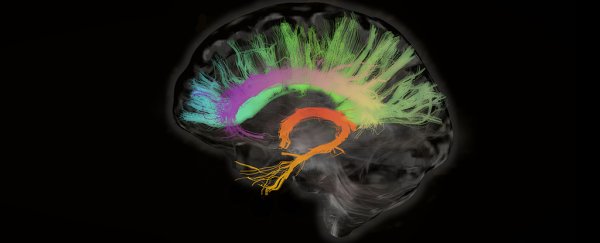Later today I'll lose consciousness for a few hours to rest and repair. There's a good chance you will, too. Yet as ubiquitous as sleep is, we know very little about which parts of the brain are fundamental to staying awake.
Thanks to a recent experiment that stimulated the brains of anaesthetised macaques, we have a clearer idea of just which neurological structures might be primarily responsible for switching us on each day.
The results not only help us to better understand the processes behind anaesthesia; for those trapped in vegetative or comatose states by illness or injury it could mean a pathway out again.
While we can use brain-scanning technologies to watch how different parts of the brain activate as a subject falls unconscious, it's a lot harder to work out how any single area produces a specific response, let alone which are the most crucial.
Studies on sleeping and comatose patients have given researchers a sound idea of the kinds of structures involved, from the brain stem to the prefrontal cortex. Needless to say, many different parts of our nervous system determine our state of awareness.
Researchers from the University of Wisconsin in the US and the Israel Institute of Technology noticed one tiny piece of tissue deep inside our forebrain – the central lateral thalamus – had a rather prominent role in directing our neurological affairs.
Based on its connectivity, it seemed to be pivotal in influencing how signals were passed from the higher-order 'thinking' sections such as the cortex to deeper structures such as the thalamus and back again – areas known to be integral to consciousness.
Researchers often focus on different parts of the brain in relative isolation to work out how relevant they might be to any given task.
In this case, the team were interested in the precise way this tiny piece of brain tissue communicated with other areas during different states of activity, requiring a more holistic approach.
"We decided to go beyond the classical approach of recording from one area at a time," says neuroscientist Yuri Saalmann from the University of Wisconsin.
"We recorded from multiple areas at the same time to see how the entire network behaves."
To get past the hurdles of using human subjects for such a task, the researchers used the macaque as their model, imaging the animals' brain structures before inserting specially tailored electrodes.
These electrodes were then used to monitor activity while the monkeys were awake, asleep, and under the effects of a strong anaesthetic.
The variations in electrical activity confirmed suspicions that the central lateral thalamus played a role in maintaining consciousness, at least in macaques. But it's one thing to find activity, and another to prove that a part of the brain is responsible for causing it.
To do this, the team used their remarkably fine electrodes to stimulate the small patch of neurons with incredible precision, tickling them into action while the macaques were knocked out with a good dose of ketamine.
"We found that when we stimulated this tiny little brain area, we could wake the animals up and reinstate all the neural activity that you'd normally see in the cortex during wakefulness," says Saalmann.
"They acted just as they would if they were awake."
Incredibly, once the stimulation stopped, the macaques drifted right back off to sleep within seconds. It was like the central lateral thalamus acted like a consciousness switch, directing mental traffic when active to give rise to awareness, and reinstating unconsciousness when it was quiet.
None of this helps much with the big questions around what consciousness is on a more philosophical level, and of course drawing conclusions about our own species based on non-human models is also problematic.
There are also potential concerns over the study method, raising questions on not just how we might qualify consciousness and distinguish it from other states of activity.
Anaesthesiologist and director of Center for Consciousness Studies at The University of Arizona, Stuart Hameroff, told ScienceAlert that the 'arousal' observed in the macaques doesn't necessarily equal consciousness.
Questions aside on whether the monkeys were truly aware or simply running through non-conscious motions, Hameroff also contests that the subjects were out cold to begin with.
"However even if thalamic electrical stimulation did restore consciousness in these 'anaesthetised' monkeys, the anaesthetic concentration supposedly being reversed is too low," says Hameroff.
No one study will be the final word on how nervous systems govern awareness, of course, and it's clear that the debate over the prominence of solitary neural tissues in relation to complex networks is far from settled.
Given we're still unclear on how anaesthesia renders us oblivious – and, shockingly, even if it's always effective – it helps having precise knowledge of how the smallest bundles of nerves affect one another while we're slipping in and out of awareness.
As for people whose brains are permanently locked into a state of consciousness, having avenues for treatment would be a welcome product of studies like this one.
Previous research has already provided strong evidence that stimulating the thalamus could help some comatose patients regain awareness.
In 2007, deep brain stimulation saw a patient who'd been minimally conscious for 6 years following a traumatic brain injury slowly regain movements and control over some body functions, including a small improvement in speech.
"There are many exciting implications for this work," says University of Wisconsin psychologist Michelle Redinbaugh.
"It's possible we may be able to use these kinds of deep-brain stimulating electrodes to bring people out of comas. Our findings may also be useful for developing new ways to monitor patients under clinical anaesthesia, to make sure they are safely unconscious."
This research was published in Neuron.
Editor's note (17 Feb 2020): To better clarify the claims over how consciousness was involved, this article has been updated with comments from a researcher who was not involved in the study.
